It’s Your Lucky Day…
Tragelaphus strepsiceros ♂ (head)” by © Hans Hillewaert. Licensed under CC BY-SA 4.0 via Wikimedia Commons – http://commons.wikimedia.org/wiki/File:Tragelaphus_strepsiceros_%E2%99%82_(head).jpg#mediaviewer/File:Tragelaphus_strepsiceros_%E2%99%82_(head).jpg
Some people nail up a horseshoe, pick up pennies, or carry around a rabbit’s foot; superstitions about how to secure your share of good luck may vary from person to person, but the impulse to try (however ridiculously) is almost universal.
Perhaps surprisingly, charms like these are one of the things that drive poaching in Africa. While elephant poaching for ivory is highly visible, on a smaller scale, many other animals are also being hunted illegally, to the detriment of the fragile ecosystems in the region. We may rub on a rabbit’s foot, but in Tanzania, these items are sought after as charms:
–
Duiker Horns
Less than two feet tall with short legs (for an antelope), the bush duiker makes for easy prey, both for predators and for humans, who often hunt it both for its meat and in retaliation (duiker may not threaten your life, but they have been known to decimate a vegetable garden).
But perhaps the greatest incentive to hunt duiker is its small, straight horns, traditionally used as a charm against evil spirits.
Maybe the spirits of hunted duiker?
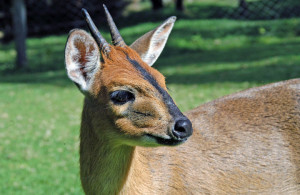
“Common duiker kenya” by Original uploader was Chuckupd at en.wikipedia – Transferred from en.wikipedia; transferred to Commons by User:Richard001 using CommonsHelper.. Licensed under Public Domain via Wikimedia Commons – http://commons.wikimedia.org/wiki/File:Common_duiker_kenya.jpg#mediaviewer/File:Common_duiker_kenya.jpg
Giraffe Tails
You’ve probably heard of poachers killing an elephant just for its tusks. Question: does that seem more or less wasteful than killing an entire giraffe for its tail?
Giraffe tails are prized as flyswatters (can’t improve on nature’s design, huh?), for the stiff hair on the tufted portion of the tail (which can be used for sewing or stringing beads), and as good-luck bracelets.
…none of which is particularly lucky for the giraffe.
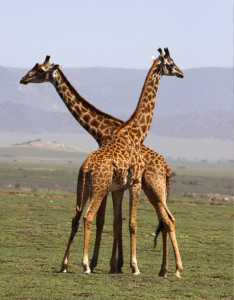
Photo: Thomson Safaris guest June Cunningham
Kudu Horns
Anyone lucky enough to spot a greater kudu on safari knows just how majestic this antelope, with its stunning, spiraled horns, can be. It would come as no surprise if kudu horns were coveted simply for their aesthetic appeal, but collectors have an even stronger incentive to snag one: they’re thought to house powerful spirits, something it’s always good to have in your pocket…or, given the lengths these twisting horns often reach, on your wall.
Kudu horns are also valued as a musical instrument (their sound is something like a French horn), and are often used in religious ceremonies, particularly in Judaism, where traditional shofar horns are often made from kudu horns.
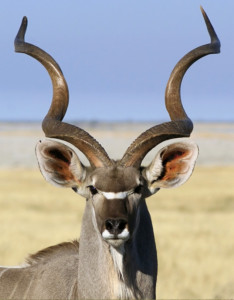
Tragelaphus strepsiceros ♂ (head)” by © Hans Hillewaert. Licensed under CC BY-SA 4.0 via Wikimedia Commons – http://commons.wikimedia.org/wiki/File:Tragelaphus_strepsiceros_%E2%99%82_(head).jpg#mediaviewer/File:Tragelaphus_strepsiceros_%E2%99%82_(head).jpg
Leopard Whiskers
You’d think anyone hunting a leopard would be after its stunning, soft coat, but many poachers bring down these big cats for their whiskers alone. Stiff and white, the leopard’s whiskers are often used in potions and charms.
Of course the leopard uses its extremely sensitive whiskers to help it navigate the dense underbrush as it sneaks up on its prey, and can remain undetected even just feet away from a target…which is a little magical, too.
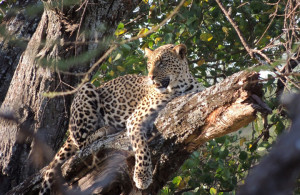
Photo: Thomson Safaris guests Karen & Brian Berkley
Oryx Horns
Another antelope whose horns are regularly turned into charms, the oryx has a long, international history of being hunted for its headpiece(s).
In medieval England, oryx horns were often sold as unicorn horns, which were believed to cure disease, ward off evil, purify water, and protect against poison.
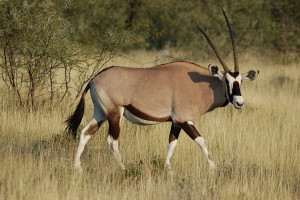
By Joachim Huber [CC BY-SA 2.0 (http://creativecommons.org/licenses/by-sa/2.0)], via Wikimedia Commons
Aardvark…Bits
You have to hand it to the superstitious when it comes to the aardvark: they’re seriously nose-to-tail about the good-luck charms.
Aardvark teeth are believed to prevent illness and generally ward off bad luck, the claws are thought to promote good harvests, the hairs are used in traditional potions, and even the meat is highly valued.
Still, we prefer spotting these odd-looking anteaters in one piece.
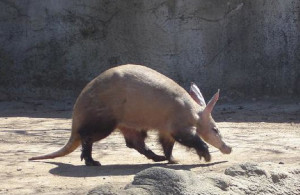
“Porc formiguer” by MontageMan is the author of the original image, I did the crop – Cropped from File:Porcs formiguers (Orycteropus afer).jpg. Licensed under CC BY 2.5 via Wikimedia Commons – http://commons.wikimedia.org/wiki/File:Porc_formiguer.JPG#mediaviewer/File:Porc_formiguer.JPG

